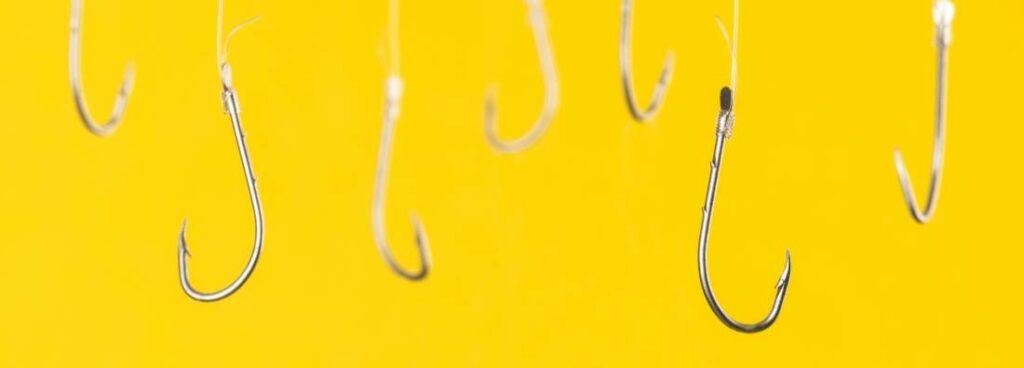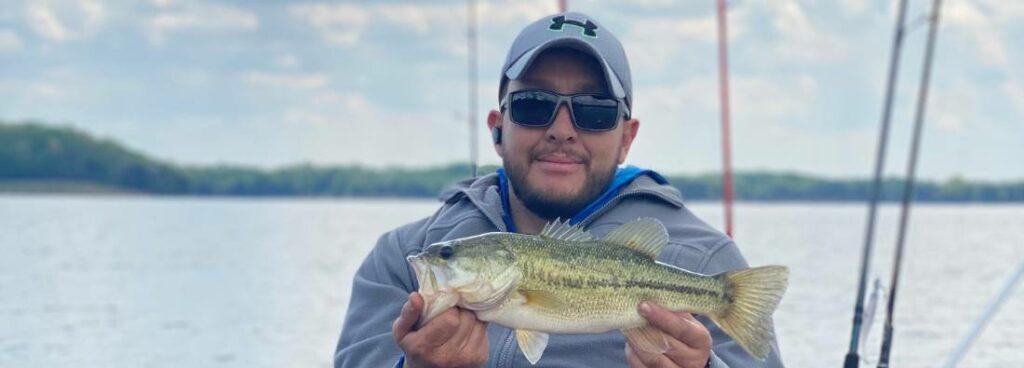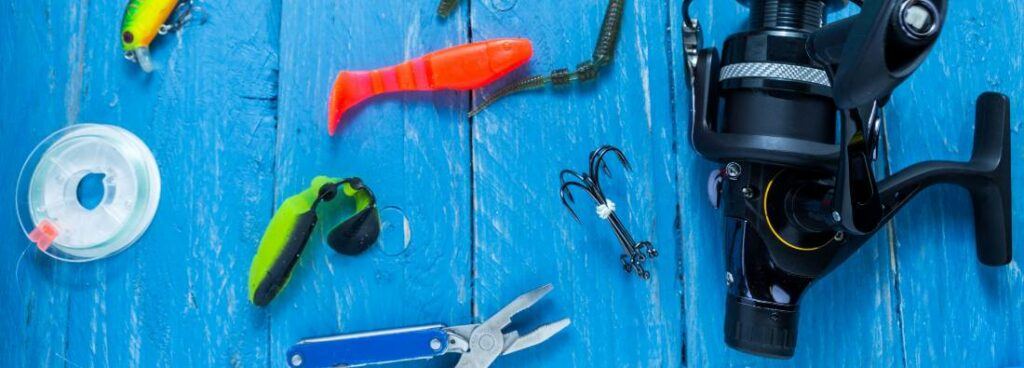Stories Worth Reeling In...
Last Updated on September 18, 2023
If you’re an angler, you know that having the proper equipment can make or break a fishing trip.
Every piece of equipment plays a role in your fishing experience, from the right rod and reel to the proper safety gear.
So you don’t forget anything, I’ll go over the ten most important pieces of fishing gear that every fisherman needs.
Table of Contents
You will need some basic supplies and tools to start fishing. These consist of a fishing rod, reel, fishing line, hooks, bait, and a fishing license. You might also want to buy a tackle box, fishing net, pliers, a fishing hat, or sunglasses to protect your eyes from the sun. Depending on the type of fishing you plan to do and where you plan to fish, the supplies and gear you will need may differ.
This one is quite obvious, your rod and reel! In fact, without them, you might end up fishing with a string & hook tied to a wooden stick!
Rods and reels come in various styles, including spinning and baitcasting, flyfishing, and many more…
I recommend the Penn Battle III Surf Fishing Combo or the KastKing Centron Combo for beginners and intermediate anglers.
In fact, I have an entire post covering some of the best and cheapest surf fishing combos out there. It’s worth a look!
Because your fishing line connects you to the fish, selecting the correct type for the type of fishing you intend to do is critical.
Fishing lines come in a variety of materials, including monofilament, fluorocarbon, and coiled.
Each has advantages and disadvantages but for most types of fishing,
If you are starting up, I suggest a monofilament line. It’s lightweight, has a strong tie, and won’t “cut” your fingers as multifilament braided lines do.

Having a wide range of hooks and lures at hand allows you to have more chances to catch different fishes and fish in different conditions.
There are various hooks and lures, such as jigs, spinners, and crankbaits, and of course, there is also good old-fashioned live bait!
Tackle boxes hold fishing gear like hooks, lures, pliers, and lines.
A well-organized tackle box is critical for keeping your equipment in good shape and readily accessible.
It also helps protect your gear from damage or loss.
Having a tackle box means you won’t have to spend time digging through a cluttered bag or searching for lost items.
Additionally, many tackle boxes are designed to be portable, allowing you to easily transport your gear to your favorite fishing spot.
So if you want to be well-prepared and efficient on the water… you better not forget your tackle box.

It is critical to wear shades and hats while fishing for several reasons. For starters, it shields your eyes and cheeks from the sun’s harmful UV rays, which can cause damage and have long-term impacts on your vision.
It also cuts down on glare on the water, which makes it easier to see fish and find your way around.
A hat will also keep the sun off your forehead, lowering your risk of sunburn and heatstroke and providing protection from rain or wind.
Overall, wearing sunglasses and hats is an easy and effective method to keep yourself safe while having fun on the water.
Bringing a fishing vest or pack on your fishing trip can greatly enhance your experience.
It makes it easy to carry and keep track of all the gear you need, like hooks, lures, lines, pliers, scissors, and more.
Thanks to the multiple pockets and compartments, you can easily access and find what you need without looking through a cluttered pack.
A fishing vest or pack can also keep you comfortable by evenly distributing the weight of your gear across your body, reducing strain on your back and shoulders.
It also allows you to cast your line and reel in your catch while keeping your hands free.
A fishing vest or pack is an essential piece of equipment for any angler.
It is strongly recommended that you bring a fishing knife when fishing.
A decent fishing knife can be used for various tasks such as cutting bait, cleaning fish, and even for safety in emergencies.
A fishing knife with a sharp blade is necessary for effortless and precise cuts.
When selecting a fishing knife, consider the blade substance, handle grip, and length.
Stainless steel blades are famous for their durability and resistance to rust. In contrast, high-carbon steel blades are renowned for their sharpness.
A good handle grip is also essential for ensuring a comfortable and secure grip, particularly when handling slippery fish.
Also, a compact and lightweight design is favored for carrying the knife in your tackle box or vest.

Choosing a good set of pliers and scissors is a personal preference, but look for ones made of durable materials like stainless steel to ensure longevity.
Pliers help remove hooks, cut lines, and bending wire, whereas shears are ideal for cutting through thicker materials like a braided line.
Pliers with built-in features such as line cutters and split ring openers are also helpful.
Keeping these items in a fishing vest or pack can save time and make fishing more enjoyable.
Investing in a fish detector or GPS can be a game changer if you want to take your fishing game to the next level.
Sonar technology is used by fish finders to identify fish. At the same time, GPS devices can help you find your way around waters you haven’t been to before and mark your favorite fishing spots.
There are portable choices, such as the Garmin Striker 4, and fixed-mount options, such as the Lowrance HOOK Reveal 7x.
Consider beginning with a portable fish finder or GPS device to get a feel for how they work before investing in a more advanced model.
Accidents can happen while fishing, no matter how seasoned you are.
That is why it is critical to have emergency safety equipment available.
Life jackets are a must-have for anyone fishing from a boat, and a simple first-aid kit can save your life if you get hurt.
A whistle or air horn to signal for assistance, a waterproof flashlight, and a throw rope to rescue someone who has fallen overboard are all items to consider.
Invest in a basic safety kit that contains the essentials for beginning and intermediate anglers.
Starting with monofilament fishing line is recommended because it’s simpler for beginners. Monofilament lines like Berkley Trilene XL Smooth Casting in 10 lb test are buoyant, versatile, and provide some stretch. While other line types have specific purposes, monofilament is a straightforward choice when starting out.
Nightcrawlers are a highly effective and versatile live bait option suitable for most freshwater fish. They are particularly attractive to panfish like bluegills and perch. A small circle hook (size 8 or 10) with some split shots above it and a float is a great setup for using nightcrawlers to catch panfish. Larger hooks and no float are recommended for targeting bottom feeders like catfish.
Live shiners are an excellent live bait choice for predatory fish like bass. Shiners are small baitfish that bass find irresistible. Similar to the setup for panfish, a larger hook and no float are ideal for using live shiners as bait. When the float goes underwater, it’s often a sign of a good-sized fish taking the bait.
A castable fish finder can significantly enhance the fishing experience by allowing anglers to see underwater and locate fish. These wireless, castable devices provide real-time information about fish presence, depth, and behavior. They are particularly useful when live bait and lures aren’t yielding results. Fish finders help anglers focus their efforts on productive areas, accelerate their learning curve, and build confidence in trying new methods.
In conclusion, proper equipment can make or break a good fishing trip.
Anglers can improve their odds of success and enjoy their time on the water by investing in high-quality gear.
Anyone seeking to better their fishing game should start with the ten essential pieces of fishing gear covered in this post.
Remember to select appropriate equipment for the fishing you intend to do.
Don’t be afraid to experiment to find out what works best for you.
Have fun fishing!